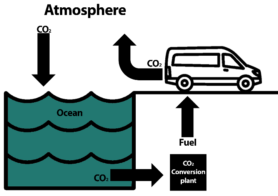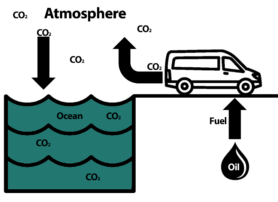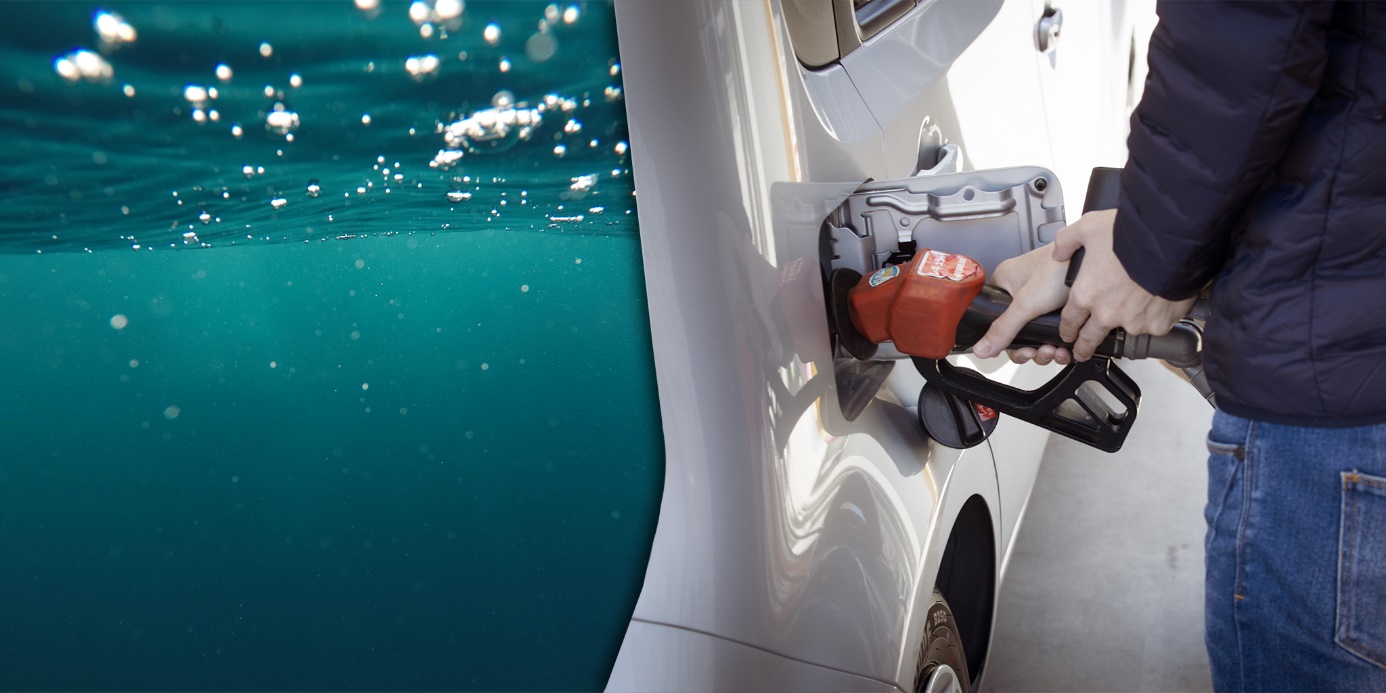Oceans and CO2
From the oceans to your car
Will the gasoline in your car be made out of oceanic CO2 in the future? It may sound strange now, but in the future this might be one of the ways we combat climate change and the warming that CO2 causes. Research conducted in 2021 by Straatman and van Sark shows potential to take CO2 from the oceans for relatively low prices. This CO2 can then be used to for a variety of applications, including the creation of gasoline and diesel.

The fuels that are created out of oceanic CO2 are climate neutral, which means that burning these fuels does not add extra CO2 to the atmosphere. The CO2 is recycled through the system, as you can see in the first image on the right. This is contrary to fossil fuels that add extra CO2 to the system, since CO2 is created by  burning coal, oil and gas. These resources are not part of the atmospheric system, so CO2 cannot be recycled like with climate neutral fuels. In the second image on the right you can see that CO2 builds up in the atmosphere and oceans.
burning coal, oil and gas. These resources are not part of the atmospheric system, so CO2 cannot be recycled like with climate neutral fuels. In the second image on the right you can see that CO2 builds up in the atmosphere and oceans.
Besides the fact that the fuels created with oceanic CO2 are climate neutral, there are more advantages to these fuels. For one the gasoline and diesel that can be manufactured can still be used to run the currently available cars. Cars that mainly run on fossil fuels. So it is possible to keep these cars around a little longer, while at the same time reducing the amount of CO2 that is brought into the atmosphere.
This is especially useful in our transition to electric cars, which could be the only type of car sold as early as 2040. By the time you see mainly electric cars on the roads, however, the climate has already changed for the worse. Thus, we have find ways to reduce atmospheric CO2 faster than the time it takes for electric to be the norm.
Another big advantage of taking CO2 out of the oceans is the increased rate at which the oceans can take up atmospheric CO2. The oceans are limited in the amount of CO2 they can hold. Thus, taking CO2 out of the ocean, creates CO2 poor water that has more room to take up CO2 from the atmosphere, compared to CO2 rich ocean water. So, by taking CO2 from the oceans we indirectly reduce the amount of CO2 in the atmosphere, which helps with reducing the warming CO2 causes.
But now you may wonder how CO2 ends up in the oceans in the first place. At the ocean surface, where the water meets the air, the oceans can absorb CO2 from the atmosphere. Due to this natural process the oceans take in about 300 tons of CO2 globally per second! Once the CO2 is in the water it can either be released back into the atmosphere at a later point or it can be taken to deeper waters by ocean currents. The CO2 can be stored in the deeper parts of the oceans up to a thousand years!

To take the CO2 out of the oceans, the researchers suggest to use an already existing innovation: So called OTEC plants. OTEC stands for Ocean Thermal Energy Conversion, which basically means that heat energy is converted into electrical energy. These plants create electric energy from the temperature difference between cold, deep ocean water and the warm, surface water. Water which has been warmed by the sun.
The warm water is used to create steam. This steam is pushed past a turbine. The rotation of the turbine generates electricity. Similar to how wind turbines work. To create the steam, the warm water is brought into a vacuum chamber. Low air pressures mean that the water turns from a liquid to gas much quicker. Similar to why water boils quicker at the top of Mount Everest than at sea level. At the same time the vacuum chamber also causes the gasses to escape from the water, including the CO2. The cold ocean water is used to cool the steam back down to form liquid water.
In most OTEC plants the CO2 is released back into the atmosphere as a waste product. One of the suggestions of Straatman and van Sark is to capture this waste CO2 and transform it into fuels. Most fuels are made from combinations of carbon (C), oxygen (O) and hydrogen (H) atoms. As you can see CO2 already contains two of the three needed ingredients to make a fuel. The hydrogen can also be gathered from the ocean water, by splitting the water molecule (H2O) into hydrogen and oxygen atoms using electricity. This means ocean water contains all the components to create fuels. So, by applying some chemistry, it is possible to create fuels out of CO2 from the oceans.
Now you might think, why go through all this trouble to get CO2 from the oceans, while we can also take it directly out of the atmosphere? Taking CO2 directly from the atmosphere is possible and will be one of the ways we will reduce atmospheric CO2 in the future. However, taking CO2 from the oceans, is much more efficient than capturing it from the atmosphere. The amount of CO2 that is present in a cubic meter of ocean water can be up to 125 times larger than in a cubic meter of air. So, you need much larger volume of air to capture the same amount of CO2 from the oceans.
There are a few limitations to this innovation. First, the innovation is still very new and more research is needed to overcome some difficulties and to find the optimum application. Furthermore, OTEC plants that this innovation needs can only operate around the equator, where the temperature difference between the surface water and the deeper water is large enough. The fuels of course can be transported all over the globe, but you probably won’t find this innovation in action in the Netherlands.
So, this new innovation will not solve the climate problem by itself. Like many other solutions to climate change, this innovation will be a part of the overall solution. But it does show potential! It is a relatively cheap way to capture CO2, thus it will be more likely become reality than more expensive alternatives. It also aids in our transition away from fossil fuels by creating a climate neutral fuels, that don’t add additional CO2 into the atmospheric system. And, lastly, by removing CO2 from the oceans. The oceans will actually absorb more CO2 from the atmosphere, reducing the effects CO2 has on the climate.
Sources
- Maint article: Straatman, P. J., & van Sark, W. G. (2021). Indirect air CO2 capture and refinement based on OTEC seawater outgassing. Iscience, 24(7), 102754.
- Interview with P. J. Straatman
- Staying time of CO2 in the Oceans: Hume D., 2018, www.maritime-executive.com, Link
- Future of electric cars: Rowlatt J., 2021, www.BBC.com, Link.

